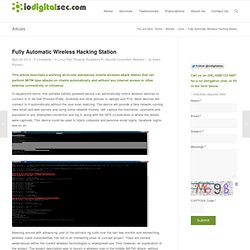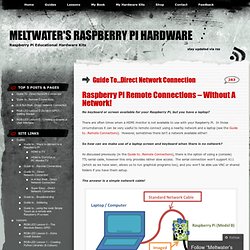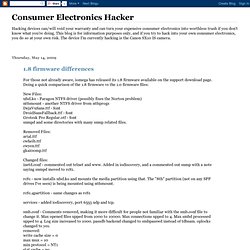

Tout est quantique. Google : son écosystème en carte interactive. Fully Automatic Wireless Hacking Station. This article describes a working all-in-one standalone mobile wireless attack station that can perform MITM type attacks on clients automatically and without any internet access or other external connectivity or influence.

In laypersons terms; this portable battery powered device can automatically entice wireless devices to connect to it, be that iPhones/iPads, Androids and other phones or laptops and PCs. Most devices will connect to it automatically without the user even realizing. The device will provide a fake network running fake email and web servers and using some network trickery, will capture the hostname, username and password of any attempted connection and log it, along with the GPS co-ordinates of where the details were captured. Montage vidéo : notre sélection de logiciels gratuits : Les challengers tout-terrain.
Guide To…Direct Network Connection. Raspberry Pi Remote Connections – Without A Network!

No keyboard or screen available for your Raspberry Pi, but you have a laptop? There are often times when a HDMI monitor is not available to use with your Raspberry Pi. In those circumstances it can be very useful to remote connect using a nearby network and a laptop (see the Guide to…Remote Connections). Some open source hardware projects, sometimes. Grbv @ piratery.net. This tool is written in Lua, and can be modified quite easily without recompilation.

Configuration files First several modules will try to read configuration files. The configuration file is named translucent = false To configure the user name used in error reports (to help me find you in my logs), you can write: user = "John Doe <john.doe@example.com>" The configuration files are Lua scripts, with globals writes going to the respective module configuration table. Command line arguments In addition to grbv.conf, all the main script configuration parameters can be set from the command line.
Atelier ALSH. Sdr. Free Online Course Materials. Machines. EnerJ. Low Earth Orbit Satellite Tracking in Your Backyard. Build your own Google TV Using RaspberryPi, NodeJS and Socket.io. Hardware Components: The RaspberryPi (Tested on Raspberry Pi model I-B, I-B+ and II-B)A USB WiFi dongle or Ethernet cable (Tested on Edimax WiFi Dongle)SD/MicroSD card (8 GB+) (check out NOOBS) Software Stack: Raspbian – a fork of Debian designed for the Raspberry Pi Node.js Socket.io – Web-sockets moduleExpress – Web-framework moduleOmxcontrol – OMX-player controller moduleChromium BrowserOMX-playerYoutube-dl – Youtube video downloaderQuo.js – Cross-platform swipe gestures libraryHTML5, CSS3 transitions, Javascript, and Moustache as a template engineYoutube API.

Fabriquez votre propre clone de Google TV avec un Raspberry Pi. Si vous avez un Raspberry Pi dont vous ne savez que faire, pourquoi ne pas prendre quelques heures de votre temps pour le transformer en véritable clone de Google TV ?

Le Lamba Labs Beirut Hackerspace a mis en ligne un tutoriel complet qui vous donnera toutes les indications nécessaires à la mise en place des logiciels nécessaires pour transformer votre Raspberry en box TV. Installation des logiciels, contenu des scripts, mise en place du backend et du frontend...etc. Pour faire tourner le moulin, vous utiliserez donc : Du boulot en perspective mais de quoi vraiment bidouiller un truc sympa !!! A lire ici Rejoignez les 53341 korbenautes et réveillez le bidouilleur qui est en vous.
Aurora. Much robotics research in recent years has been devoted to the subject of odometry. Knowing a robot’s precise location in the world is key for navigation and obstacle detection and avoidance. Currently a number of methods are used, including wheel odometry, GPS, and SLAM systems, but each of these has flaws in its current implementation. Because wheel odometry is inherently an indirect measurement, it is only valid for short periods of time and fails completely if the vehicle is running on sand or another similarly deformable material. GPS is prone to outages and failures in canyons and under bridges and has an exponential price-accuracy relationship. SLAM performed on external landmarks is processing-intensive because of the feature-recognition and matching necessary. By using an optical mouse chip to track the ground directly beneath the vehicle, we can overcome these obstacles. This is not to say, though, that using an optical mouse IC does not come with its own problems.
RH Workshop: Open Source info for the TIPIC. PCB Heaven - Aurora. Consumer Electronics Hacker - Aurora. I needed to detail what I found out about the upgrade.bin file and how.

If you want to know the format, just jump to the end of this post. I'm going to detail how I figured out the format. For hacking this, HxD is one of the best programs in the world. And free, too!! I set it to view 16 bytes at a time, both ascii and hex. Right away, I see filenames near the beginning. Obviously the filename starts at offset 0x8 in that file structure. So now to look at the header bytes. There a dword for 8.
Nothing else seems familiar. Looking at the differences in hex between the R1 and R1.1 upgrade.bin files, I see a change in offset 0x08-0x0b and another one at 0x10. Arduino. Electronics. Basic Circuits. Hackerspace.